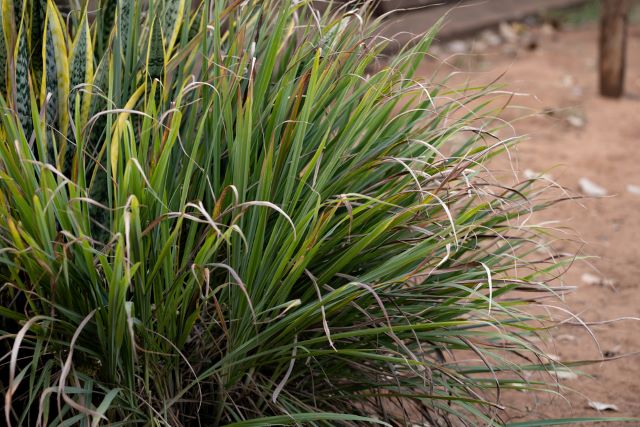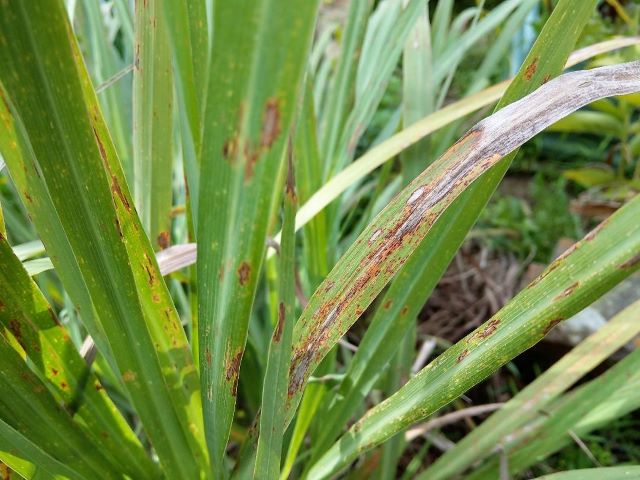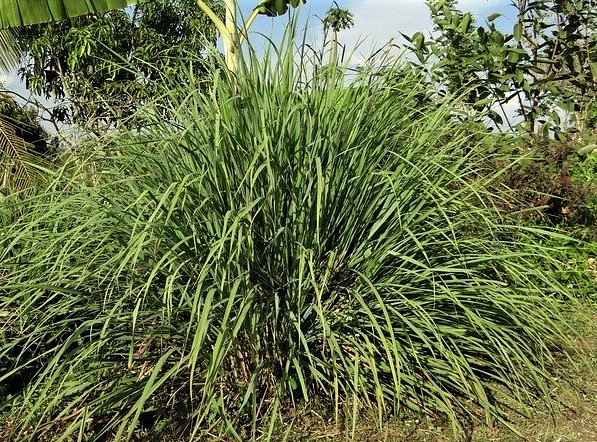Lemongrass is both a fragrant and beautiful plant that many of us love to add to our planters for its pest-repellent and medicinal qualities. Known for its strong citrus flavor, lemongrass is a popular ingredient in many soups, teas, and sauces. It is also one of the most well-known ornamental grasses that add appeal to your garden beds. So if your lemongrass plant is dying, you’ll want to know why and how to fix it.

When planting lemongrass, it is important to maintain proper soil conditions, provide adequate lighting, and keep your plant well-watered. Without proper care, your lemongrass plants may start to wilt, yellow, droop, or brown. If you notice your lemongrass plant starting to die, it may be time to look into some of the most popular causes of lemongrass plant death.
Proper care is essential to a thriving lemongrass plant. Although lemongrass is easy to grow, there are still some common issues that can lead to your lemongrass plant dying if left untreated.
Table of Contents
Lemongrass Plants Require Lots of Water
Ornamental grasses, like lemongrass, will thrive when they are abundantly watered each day or so. These plants thrive in humid areas with heavy rainfall.
Typically, lemongrass thrives organically in eastern and southern countries by soaking up the rainwater from the soil. However, you need to routinely water your lemongrass each day or so if it does not rain in your area.
To keep your plants well-watered, spray them with water every day or every second day in the summer and less often during the cooler months.
Add mulch around your lemongrass plant to prevent evaporation of moisture from the soil. And do not let the grass roots dry out to prevent stunted growth.
Lemongrass Plants Require Proper Drainage
Lemongrass plants will thrive in moist soil, but not soggy soil. Overwatering or poor drainage can also lead to your lemongrass plant dying.
When your lemongrass has too much water in its soil, it will become yellow or brown in color and eventually die. Pots and containers need to have plenty of holes to encourage proper drainage of water and prevent boggy soil.
To test the moisture level of the soil around your lemongrass, stick your finger into the soil. If you feel too much moisture, you will need to locate the blockage or drill more holes into the container.
Refrain from watering lemongrass plants in soggy soil to allow time for the roots to soak up the water.
Lemongrass Plants Need Nitrogen
Lemongrass plants require soil rich in nitrogen to encourage growth. These conditions mimic the tropical climate in which they thrive.
Upon planting, choose a quality soil mixed with mature and nutrient-dense compost. It is important to add more nutrients to your soil by fertilizing every few months during the growing season.
Lemongrass should be planted in soil with a pH of 5.5-7.5. You can test your soil to check for proper pH levels using a soil test kit to learn the conditions of the soil in your garden. These results will indicate whether your soil contains enough nitrogen for growing grasses including lemongrass. If you have poor soil conditions, you will need to add fertilizer to prevent brown leaves on lemongrass.
Be sure to choose a fertilizer that is rich in nitrogen. Nitrogen encourages quick growth of grasses and green foliage that do not flower. There are many fertilizers on the market, but one that I really like for lemongrass is an organic fertilizer like this one. It will have the right balance of nutrients to encourage the growth of new grass shoots.
Lemongrass Plants are Prone to Fungal Diseases

If you still notice brown spots or streaks on your lemongrass plant leaves, your plant likely has a fungal infection. Grasses are prone to fungal diseases that need to be treated before plant death.
Rust
Brown leaves with yellow streaks are often a symptom of rust from spores spread by the wind or rain. Take a look at the underside of your lemongrass. Do you spot dark brown postules? This is a tell-tale sign of a fungal infection due to rust.
To prevent lemongrass plant rust, you need to routinely remove any dead or diseased grasses from the plant and nearby soil.
Cover the soil with mulch to stimulate healthy plant growth.
Also, water the lemongrass plant near its base to prevent moisture buildup on the grass shoots.
Blight
Brown leaves may also be a symptom of leaf blight, another common fungal infection that affects lemongrass.
Symptoms of leaf blight include reddish-brown spots on the tips and margins of the lemongrass. These leaves look and feel very dry.
To treat leaf blight, apply a natural fungicide, like this one, and remove any infected leaves from the plant.
Red Leaf Spot
Red leaf spot can also attack lemongrass plants, causing reddish-brown lesions to develop on the leaves. These lesions are often sunken, making them easy to spot.
Commonly found in tropical areas, red leaf spot thrives in humid, hot conditions.
To prevent your lemongrass from developing red leaf spot, keep your plants well-spaced and properly irrigated. If you notice any of these lesions, treat with fungicide.
Lemongrass Plants Have a Few Pests
Lemongrass may be a natural pest-repellent, but it still has a few nagging bugs that can cause harm to the plant. Pests that attack your lemongrass plant will cause it to slowly die.
You might first notice yellow or wilted lemongrass leaves. Eventually, these grasses will fall off the plant. Once you notice these issues, thoroughly inspect your lemongrass to look for these common pests.
Mealybug
The most common pest to attack the lemongrass plant is the mealybug. Drawn to the citrus fragrance of the lemongrass, mealybugs will feed on the sap of the plant.
Over time, this will cause the grasses to wilt or yellow. Small and oval in size, these bugs thrive on new growth. They release a waxy coating onto the lemongrass plant that can also cause moldy fungal infections.
To safely repel mealybugs from your lemongrass plants you can use insecticidal soap or horticultural neem oil.
Aphids
Because of the large leaf area of the lemongrass plant, they also attract aphids.
Aphids, also sap-sucking pests, suck sap from the grasses and eventually cause wilting and yellowing of the lemongrass leaves. You may also notice curling or misshaped leaves.
If untreated, aphid infestations can become fatal to your lemongrass plant.
Take these steps to prevent aphids from destroying your lemongrass:
- Manually remove aphids from the grass shoots
- Treat with insecticidal soap
- Spray infected areas with a hose and let dry completely
- Treat with non-toxic pesticides
- Cut back the leaves
- Be mindful of neighboring plants
How to Revive Your Dying Lemongrass Plant

Once you notice these issues with your lemongrass plants, you need to take the steps to revive the plants before they die.
Check the Soil Moisture
To prevent any overwatering, check the moisture of the soil before and after watering. Press your finger into the soil around the lemongrass plant to feel for any moisture present.
Ensure proper drainage from the container by inspecting the soil for any pooling or lack of drainage. Drill holes into the bottom of your containers or repot your lemongrass plants into new containers.
Remove Brown or Dead Lemongrass Leaves
Cut off any brown, drooping, or yellow leaves from the lemongrass plant. Use garden shears to remove these leaves with less than 1.5 inches (3 cm) left on the branch.
Once the leaves are cut from the plant, remove them from the garden or container. Once the lemongrass leaves have started to wilt or brown, they may have been exposed to a fungal disease. Leaving them behind puts the rest of the lemongrass plant at risk so be sure to remove them.
Stick to a Watering Schedule
To prevent over- or under-watering your lemongrass plants, stick to a watering schedule. This schedule can establish a routine that both you and your plants will adjust to, making it easier to maintain a thriving lemongrass plant.
Plant Lemongrass at the Right Time
Lemongrass should not be planted outside until after the threat of frost is gone. If you live in a climate with late winters, take the time to wait until temperatures rise in your area.
The tender roots of a lemongrass plant will suffer from the cold. So watch for late frosts and cover any lemongrass plants you may have outside to prevent damage from frost.
Give Lemongrass Space to Grow
Many lemongrass plants fail to thrive because their containers do not have enough space for their growing roots. Once the lemongrass roots fill the container, the leaves will start to turn yellow and brown before they die.
As a good rule of thumb, you should plant your lemongrass plants in a minimum of a 5-gallon planter.
Remove Debris or Dead/Decaying Leaves
Fungal infections can cause your lemongrass plants to die. These infections are often caused by dead, decaying, or diseased branches, leaves, or debris that may find its way near your lemongrass plant.
Inspect your gardens on a routine basis and clean out any debris or dead plants from the soil.
Provide Adequate Sunlight for Lemongrass
Sunlight is another essential ingredient to the success of your lemongrass plants. Without proper sunlight, your lemongrass plants will begin to brown. You may also notice stunted growth.
So plant your lemongrass in locations that receive at least six hours of full sun each day. If you plant your lemongrass indoors, be sure to place it near the window.
Related reading:
